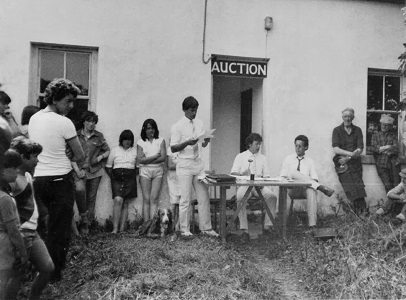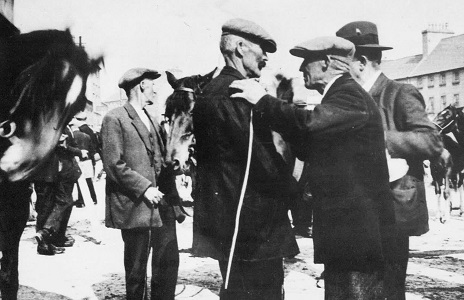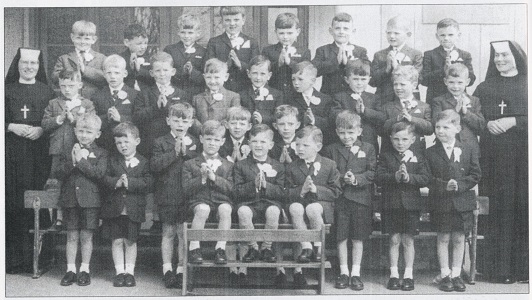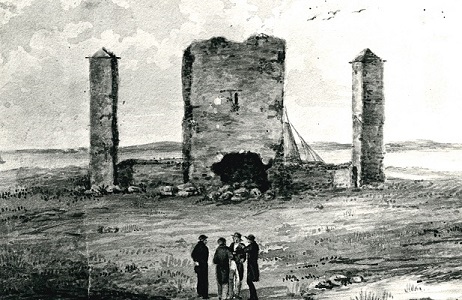Old Galway
GALWAY AUCTIONEERS

by Tom Kenny
An auctioneer is described as an agent who accepts bids and sells goods at auction. The profession goes back thousands of years. In ancient Babylon for instance, they used to hold auctions of women for marriage, indeed it was considered illegal to allow a daughter to be sold outside the auction process. In ancient Rome, they regularly held slave auctions. The idea of auctions as we know them today began in England in the late 17th century. They were referred to as English Auctions where bids came in an ascending order.
In 1825, there were three auctioneers listed in Galway, James Clinch, High St; Andrew McHugh, Lombard St. and Michael Martin, Shop St. Some thirty years later, that number had grown to five, Thomas Connell, Churchyard St: Michael Mannion, Abbeygate St: Jim Nevin, Middle St: Thomas O’Connell, High St, and Edward Staunton, Lombard St.
MERLIN PARK HOSPITAL

by Tom Kenny
Tuberculosis is an infectious and very debilitating disease that affects the lungs. It was previously known as consumption because of weight loss suffered.
The planning for regional sanatoria to fight this disease in this country began in 1945 before Streptomycin and other anti-tuberculosis drugs were anticipated. A Government Act of that year enabled the Department of Health to compulsorily buy land and property suitable for such hospitals. The original site chosen in Galway was the property of Col. Joyce in Mervue. He and his wife came to an arrangement with the department for the sale of his 8 acres and plans were being drawn up for the siting of 40 bedded units. However, the Redemptorists, whose house of studies was next door, objected, and so the search for another property began.
HORSE TRADING IN EYRE SQUARE

by Tom Kenny
One of the earliest associations of Eyre Square with the horse was the jousting competitions that went on there in the middle ages. There were also horse fairs held in the Square where one could buy and sell horses, these were usually held outside the railings and on the streets. Before motorised machine were invented, the horse provided people with their main type of transport: the work horse was an invaluable part of the farm used to pull the plough or haul the farmer and his cartload of produce into town. Horse racing was always a popular sport and the first Galway Horse Show was held in the Square in 1892.
HURLING, GAME OF LEGEND AND OF LEGENDS

by Tom Kenny
Hurling is one of the oldest field games in the world. Some stories portray it as a form of military training, proficiency on the field equated with skill in battle. Legend has it that the first battle of Moytura fought about 2000 B.C. between two rival tribes, was preceded by a fierce hurling match between two teams of 27 a-side drawn from opposing forces. The casualties were buried under a huge stone cairn – a megalithic tomb. The field where the game took place is still called The Field of the Hurlers. Ancient games were also played at Tara.
Lowry Loingseach, the legendary pagan king with the ass’s ears was suddenly cured of deafness when accidentally struck by a hurl in a hurling contest. Setanta was a warrior hero and a demigod whose feats on the hurling field are legendary, he killed the savage hound of Culainn in self-defence and thereafter was known as Cú Chulainn. Fionn Mac Cumhaill and the Fianna played hurling. Some kings left up to 50 hurleys and hurling balls in their wills so that their sons and warriors would carry on the noble game. The earliest written reference to the game was in the 5th century Brehon Laws. Hurling was outlawed in the 12th century by the Normans and later a bishop threatened to excommunicate any Catholic who played the “reprehensible game of hurling since it led to mortal sins, beatings and homicides”.
THE HAPPIEST DAYS OF OUR LIFE

by Tom Kenny
It may be a cliché but the old adage that the happiest days of our life were the ones we spent at school would be true for most people. When we were in school, we probably thought that it was all lies, but later we gradually realised it was true. Life changes with time but memories of our school days remain the same all the time, days of laughter, smiles, great friendships, games in the school yard, no worries of bills, taxes or finances, desks with flip-tops and inkwells in the middle, heavy school bags, the glantóir, headline copies, the poems we learned, the sheer joy of the last day before the holidays, the imaginative excuses for being late … “The two wheels fell off me bicycle, sir”.
TOBAR ÉANNA, ST. ENDA’S WELL, BARNA WOODS

by Tom Kenny
In many cases, ancient folklore linked holy wells with a god, a goddess, a mythical creature or a serpent, they were places of pagan worship which were at odds with Christianity. Ever since medieval times, efforts have been made to stop well-worshipping and to Christianise them. Many townlands have a water source that has been marked out for special devotion, most of them being allied to a particular saint. These are usually sanctuaries within the landscape, threshold sites that enable us to step back from the hullabaloo of daily existence and allow us to access something grander and otherworldly, something infinite and unknown.
STEAMBOATS COME TO GALWAY

by Tom Kenny
One hundred and fifty years ago, on the 17th of August 1672, the paddle steamer Citie of the Tribes was launched in South Shields in England. She was built by J.T. Eltringham, weighed 117 gross tons and was registered for the Galway Bay Steamboat Company. Her arrival in the docks caused great excitement. She was hailed as heralding a new future for shipping in the west, the age of steam! She was the only steamboat in Galway, a paddle tug about 96’ x 18’ x 9’, and as you can see from her schedule for July 1875 printed here, she was a busy vessel. On the days not listed, she travelled on excursions or to Aran.
INIS CAORACH, MUTTON ISLAND

by Tom Kenny
In the year 1124, the town was put in a state of security and a strong castle was built at Dún Bun na Gaillimhe (the fortification at the mouth of the Galway River). Several times in the next century, the Kings of Munster invaded Connacht bringing death and destruction and usually destroying the town and the buildings on the island. In 1190, there is a reference to Lismacuan, ‘The fort on the Mouth of the Harbour’.
In 1641, an order was made that the islands of Mutton Island, approximately 3 acres, were to be made use of as a commonage by the inhabitants of Galway and the Liberties thereof. From a military point of view, the island was of great strategic importance. When the city was under siege in 1651 “The enemie…. Caused some Parliament vessels to anchor on Galway’s harbour, and to land some men on Sheepe Island to master the towns from them: with his ordnance very commodious, the number four score and ten choice mariners and other lustie men were then landed, to build half moones, redoubts and other inginier-works, to mount their artillerie against the towne …. The worke was begun, which if finished, doubtless the towne could not subsiste”.
